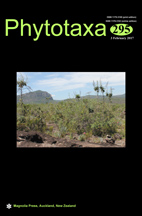Abstract
A replacement name, Cryptantha juniperensis, nomen et status novum, is proposed for Cryptantha nevadensis A.Nelson & P.B.Kennedy var. rigida I.M.Johnston. A new name was necessary because the name C. rigida was unavailable, due to its previous use for the South American Cryptantha rigida (Phil.) Reiche. Cryptantha juniperensis is similar to what has been treated as Cryptantha nevadensis var. nevadensis, with which it shares appressed upper stem trichomes and a relatively long fruiting calyx, often with erect to reflexed apices. However, Cryptantha juniperensis differs significantly from Cryptantha nevadensis var. nevadensis by the nutlet shape, which is narrowly ovate to widely lance-ovate, narrowly acute, and tuberculate in the former but lance-ovate, strongly acuminate, and elongate-tuberculate to muricate in the latter. In addition, Cryptantha juniperensis is erect (vs. lax and sprawling in Cryptantha nevadensis var. nevadensis), has fruiting calyces between 4.5–7.5 mm (vs. 6–11 mm long), and has a corolla limb that ranges between 2–5 mm in diameter (vs. 1–2 mm in diameter). Cryptantha juniperensis, which has also been classified as Cryptantha intermedia (A.Gray) Greene var. rigida Brand, is similar to recognized varieties of C. intermedia in nutlet morphology and in growth habit but differs in having upper stems with trichomes mostly appressed (vs. mostly spreading), a smaller corolla size (ca. 2–5 mm vs. 3–11 mm), and cymules that are mostly paired (vs. cymules that are arranged in threes). Preliminary molecular studies also support the recognition of C. juniperensis as a taxon separate from both C. nevadensis and C. intermedia.

